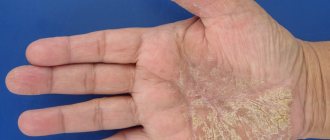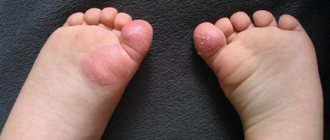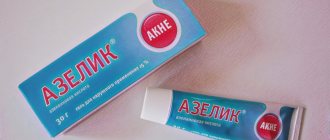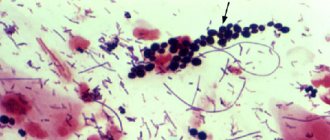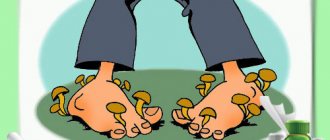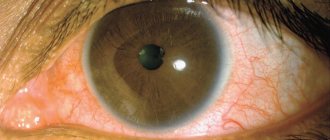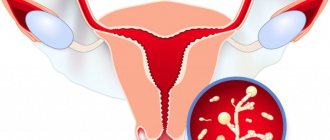Many of our patients seek advice regarding cracked and chafed skin between their toes. Especially in summer, the problem seems to grow. Patients notice small whitish blisters or ragged skin on their own or their children's legs and think it is ringworm.
However, in most cases we can reassure: dermatophytosis is a relatively rare disease in our latitudes, provided hygiene standards are observed. Most often we deal with maceration.
What is maceration?
On hot summer days, almost all the feet sweat. One of the purposes of sweat is to cool the body, and therefore it is completely natural in the summer. Then the whole body, and therefore the feet, cool down. After all, there are over 500 sweat glands on the soles of our feet.
However, too much sweat on the feet can cause maceration, that is, softening of the epidermis. The macerated epidermis loses the features of vital tissue and becomes dead tissue.
Maceration in the interdigital spaces appears as cracked, uneven whitish epidermis. If this occurs on skin with hyperhidrosis, the skin around the maceration becomes intensely red and noticeably moist.
Diagnosis of mycoses
A consultation with a dermatologist will allow you to establish a preliminary diagnosis based on knowledge of the characteristics of the course of the fungal infection.
Analysis of the scraping will determine the presence and type of fungus, which greatly facilitates the choice of antifungal antibiotics.
General tests of blood, urine, and feces can determine possible disturbances in the functioning of internal organs, leading to a decrease in immune defense and disease.
Modern private clinics in Moscow offer] calling a dermatologist at home[/anchor]. This type of consultation allows you to undergo diagnostics and receive prescriptions without leaving your home. Calling a doctor to your home is recommended for elderly people, patients with skeletal injuries, women with infants and anyone else.
Methods for diagnosing skin diseases:
- Diagnosis of skin diseases
- Diagnosis of skin diseases at home
- Diagnosis of allergic skin diseases
- Diagnosis of bacterial skin diseases
- Diagnosis of viral skin diseases
- Diagnosis of hair diseases
- Diagnosis of nail diseases
- Diagnosis of skin tumors
- Skin scraping
- Blisters on the skin
- Dermatoscopy
- Demodex tests
- Diagnosis of sexually transmitted infections
- Mushroom tests
- Skin scraping
Why does the skin between my toes crack?
In summer, maceration often occurs on normal skin, which usually does not sweat much. The reasons for this are increased air temperature, and, consequently, skin temperature, lack of air circulation between the fingers and accumulation of moisture. The friction of the toes against each other and the pressure of the surface of the skin on the soles of the shoes cause cracking of the thin and delicate epidermis between the toes.
Sometimes the cracks in the transitions from the interdigital surfaces to the sole are deep. We then see whitish, uneven areas of the epidermis surrounding the crack in the skin, which is often painful. Then we are faced with a wound that requires fast and effective treatment, because not only fungi, but also bacteria can penetrate through an open wound.
Maceration can occur on all areas of the foot. Calluses, plantar indentations and the area on the lateral surfaces of the toes can become macerated, that is, softened by sweat and other fluids.
Treatment for itching between toes
The first thing you need to do before starting treatment is to throw away all items that have been in contact with the affected areas of the skin of your feet: socks, slippers, washcloths, pumice stones for your feet. Shoes should be thoroughly treated - wipe the inner surface with a vinegar solution, alcohol, it is better to replace the insoles with new ones.
These simple measures will help avoid re-infection.
Medicines to treat fungal infections are used both orally and topically. In mild cases of the disease (initial stages), treatment may be limited to local treatments.
Treatment principles:
- Elimination of prerequisites for the proliferation of fungi. It is achieved by using baths with acidic solutions that have a tanning effect. Burov's solution is effective.
- Destruction of fungus. For this, ointments with miconazole and tolnaftate are recommended.
- To treat affected nails, it is necessary to use tablet forms of antifungal drugs: Lamisil, Nizoral, Griseofulvin.
- Increasing the body's immune defense. Taking stimulants: thymogen, levamisole,
- t-activin will speed up recovery and reduce the risk of relapse.
Treatment on average takes no more than a month, unless the disease has taken a generalized form. After stopping therapy, the doctor will set a date for repeat tests.
The “Your Doctor” helpline offers many private clinics where competent dermatologists provide consultations, relying on the achievements of modern pharmaceuticals in the treatment of skin pathologies.
Publication date: 2018-02-03
Hypergranulation and maceration
Maceration is often accompanied by ingrown nails and hypergranulation. The area is always wet, and therefore an infection easily attaches to the wound, which quickly moves from the side to the back, that is, the base of the nail plate. A purulent paronychia forms with pronounced redness and pain.
If timely treatment is not carried out, paronychia can spread to the finger tissue and cause panaritium, inflammation of the lymph nodes.
If maceration can be treated in a podologist’s office, then associated complications require contacting a surgeon.
Forms
Forms of fungus
Doctors identify several forms of fungal infection, which differ in severity, method of treatment and cause of occurrence. Microorganisms can affect either one toe or the entire foot if therapy is not started in a timely manner. Let's take a closer look at the types of mycosis:
- Erased form. Doctors characterize this stage as initial. First of all, minor cracks appear on the skin between the fingers, it becomes dry and begins to peel, especially in the folds between the fingers.
- Dyshidrotic form. This type of pathological process is characterized by the formation of clear and visible papules, inside of which there is a liquid component, and the surface membrane is quite dense. The main symptom is severe itching between the toes.
- Scavomotic-hyperkeratotic form. Between the toes on the epidermis, seals begin to form that have an unnatural blue-red color. In the area where the fingers bend and there are folds of skin, a whitish film is visible. The foot also becomes covered with bumps that resemble calluses. There is severe itching.
- Intertriginous form. The favorite places to localize wounds are the third, fourth and fifth fingers. At the site of the lesion there are visible violations of the integrity of the skin, represented by cracks, erosions, itching and swelling are also present, the epidermis is red.
The main mistake of a patient who discovers wounds between his toes is that he does not think about the progression of the fungal infection, thereby exposing others to infection. In addition, he loses precious time during which microorganisms strengthen, which will lead, in the future, to the need to take stronger drugs and increase the recovery period.
What is the difference between maceration and mycosis?
In contrast to maceration, mycosis is sometimes caused by Trichophyton rubrum or Trichophyton interdigitale. Mycosis on the feet differs from maceration in both appearance and smell. The smell of mycosis is very characteristic and is easily recognized by an orthopedist.
The appearance of mycosis is distinguished by its yellowish-brown color and the presence of additional, not yet cracked, microscopic bubbles that appear next to the already cracked and jagged ones. The vesicles are filled with liquid containing fungal spores. Often they are so small that only the experienced eye of a podiatrist can see them with a magnifying glass. Deposits of necrotic, fungal epidermis can stick together, becoming a threat to the formation of interdigital ulcers, which are very painful and difficult to remove and heal.
Most common location of callus
Considering that the formation of thickened skin with calluses and corns is due to a protective mechanism, protecting its damage from the action of traumatic factors, the prevalence of these conditions is very high. There is hardly a person who has no idea about the essence of the existing problem and has not personally encountered such manifestations. In her professional activities, podologist Mikula N.V. Faces the fact that most often these skin defects form on the heels, toes and between them, because wearing uncomfortable shoes is quite typical, often dictated by fashion trends.
Depending on the characteristics of repeated physical activity and friction of the skin against various objects, the most typical place for the formation of calluses in people of manual labor, gymnasts, rowers, is the fingers or the inner surface of the palm; in schoolchildren who write with a pen, it is the middle palm of the right hand. For drivers and people involved in agriculture, the localization of the pathological process on the hands is also due to the peculiarities of their profession.
Why is it important to diagnose and treat maceration?
Eliminating maceration is the basis of foot health: eliminating unpleasant odors and the risk of infections.
Recommendations:
- Medical pedicure. Removal of keratinization and affected epithelium using a hardware method.
- Treatment of an ingrown toenail. (If pathology is present). The method is selected individually and depends on the position of the nail and the condition of neighboring tissues.
- Foot hygiene. Regular independent and proper care reduces the risk of infection and maintains the results of a hardware pedicure. Recommendations for care will be given individually by a podiatrist.
- Comfortable shoes. According to season and size, made of natural materials and orthopedic insoles.
If, due to maceration, the interdigital spaces are affected by mycosis, along with a medical pedicure, it is advisable to consult a dermatologist to receive pharmacological treatment.
Treatment
To completely heal wounds between the toes, a complex effect on the entire body is necessary. Therefore, medical workers carry out therapy according to the following scheme:
- Initially, the patient’s endocrine function and digestive system are brought back to normal;
- After this, drugs from the group of antibiotics and steroids are withdrawn, and the patient is prescribed multivitamin complexes and dietary nutrition (excluding fatty, sweet and fried foods);
- The next step will be the use of local products, for example: Nizoral, Nystatin, Travogen, Exoderil, Ecozax, etc.;
- Systemic medications will also be indicated: Fluconazole, Itraconazole or their analogues.
With this approach, almost 100% of patients recover completely in a short time and do not experience relapses. After the final diagnosis has been made, and the doctor knows for sure that wounds have appeared between the toes due to the rapid proliferation of the fungus, that is, the patient has an acute form of the disease, at the first stage he will be offered to stop the pathological process by treating the affected areas with Castellin ( liquid preparation). Only after this can you begin to apply medications in the form of a spray, gel, ointment or powder. The thing is that initially actions should be aimed at stopping the inflammatory process, and only after that local treatment can be carried out. When the patient seeks medical help in a timely manner, that is, he has a disease at an early stage, ointments with an antifungal effect will be immediately prescribed. In situations where the pathological process affects the deep subcutaneous layers, it will be necessary to take systemic antimycotic agents. It should be noted that the treatment of wounds between the toes can be of a combined type: the use of local ointments and oral administration of antifungals. The course duration can range from several weeks to one year, depending on the degree of complexity of the primary disease and the resistance of the infection to drugs.
Folk remedies
You can also try to get rid of wounds between your toes using traditional medicine. There are many effective recipes, including foot baths with salt and soda. To prepare it, you need to take a basin and fill it to the desired level with water at room temperature. Then thoroughly mix one tablespoon of salt and soda into the liquid. When the components dissolve, you need to immerse your feet in them and wait 15 minutes. Afterwards, wash your feet with warm water. You can resort to using a bath, where the main component is wine vinegar. You should also take a container of warm water, add enough wine vinegar to it to create an acidic environment, and immerse the limbs for 7 minutes. Then remove the legs, but do not throw out the water. Socks made of natural fabric are soaked in it and put on the feet to consolidate the effect. It is best to do the procedure before bed.
Spurge
You can prepare a foot bath using milkweed herb. To do this, take fresh leaves of the plant, you can also use the stems, pour two liters of boiling water, wrap it, and leave it to steep for about three hours. After the allotted time, the legs are lowered into the solution and kept for about 40 minutes. It is best to carry out the procedure no more than three times a week until the wounds go away. A bath based on ground coffee will be no less effective. You need to take two liters of boiling water and brew ground coffee in it, leave it to steep for a few minutes, then immerse your feet in the basin and leave for about 20 minutes. The procedure has not so much a therapeutic as a cosmetic effect because it effectively removes the unpleasant odor caused by fungal microorganisms. If you consider treatment at home, but using pharmaceutical drugs, then you should pay attention to such a remedy as salicylic acid. You can use it to make foot baths and compresses. The only thing that is required from the patient is strict adherence to the regularity of the procedure and the recommended dosage. You need to take salicylic acid 1% concentration and add it to a bowl of warm water. After this, you need to immerse your feet in the liquid and leave to steam for 15 minutes. The duration of therapy can be no more than one month, after which you should take a break for 10 days and, if necessary, repeat the procedure. If the rules are not followed, there is a risk of skin burns. Therefore you should be very careful. In any case, before using any recipes from traditional medicine, you should consult a doctor and tell him about your intentions. Only after its approval can you begin treatment according to “grandmother’s” recipes. It is also important to remember that folk remedies cannot completely replace traditional therapy. Therefore, herbs, compresses and baths can only be included in the therapeutic complex prescribed by the attending physician.

